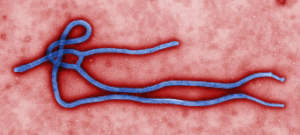The Ebola Outbreak
Thomas Britt, MD., MPH

Endemic areas of West Africa
The Ebola viral outbreak or epidemic is considered the worst outbreak in the history of the west African nations of Liberia, Sierra Leone and Guinea. Ebola virus is one of many causes of viral hemorrhagic fever (Ebola HF). According to the World Health Organization (WHO), 6 August 2014, the Ebola outbreak has infected 1779 and killed more than 961 people since March 2014. As of 30 August 2014, more than 3,000 infected and the death toll has risen to 1552. Ebola HF has a high case fatality rate, ranging from 50 – 90%. The onset of symptoms, post exposure, typically occurs within 8-10 days, however they can develop between 2-20 days. Worldwide concern continues to grow, speculating that this geographic epidemic may become a pandemic, especially in the United States, and the United Kingdom, as both receive direct flights from those affected nations.
The WHO reported on August the 7th 2014, that four new cases of Ebola were identified in Lagos, Nigeria. Reportedly all cases were related to those persons who had direct contact with Patrick Sawyer, an American citizen suffering from Ebola HF who collapsed in the Lagos airport.
He was taken to the hospital for treatment where he died, 25 July 2014. Contact with him led to the reported cases. The mode of transmission and protection are paramount public health concerns. We have yet to reach hysteria, however increased concern may in part be fuelled by the 1995 movie entitled, Outbreak. Hollywood depicted the Ebola HF outbreak as airborne, extremely short onset of symptoms with severe hemorrhaging and certain death. Public health officials believe that the Ebola virus may indeed make its American entrée, however it can be controlled, treated and effectively contained. Unfortunately available evidence so far does not support local geographic containment, prompting the National Institutes of Health to consider beginning human trials, in search of a vaccine.
Etiology
This virus was initially discovered along the Ebola river in the Democratic Republic of the Congo in 1976 … hence the name Ebola virus (EV). EV is a member of the Filoviridae family and genus, Ebolavirus (see adjacent photo) Five subspecies have been identified:
- Zaire Ebolavirus
- Sudan Ebolavirus
- Tai Forest Ebolavirus (formally known as Cote d’Ivoire)
- Bundibugyo Ebolavirus
- Reston Ebolavirus

Current evidence indicates that the Reston Ebolavirus causes disease in monkeys, gorillas, and chimpanzees, but not humans. The other four subspecies cause viral hemorrhagic fever in humans.
Mode of Transmission
- Transmitted via direct contact with blood, body fluids or tissues from an infected and symptomatic person or contaminated objects from infected animals
- Ebola is not transmitted by air, water, nor food
- Infected individuals who are not symptomatic are not contagious
Researcher suggest that bats are the likely reservoir for Ebolavirus, however more definitive evidence required to confirm a natural host.
Signs and Symptoms
- Fever
- Hemorrhaging (bleeding internally and bleeding from the eyes)
- Musculoskeletal pain and weakness
- Rash
- Difficult breathing and swallowing
- Stomach pain, nausea, vomiting
- Decreased appetite
Hemorrhagic fever is also seen in other tropical diseases, i.e., Dengue. Unless there is a clinical index of suspicion followed by proper diagnosis in its early stage, Ebola HF may be missed, leading to ineffective, prompt treatment.
Preventive Measures
- Refrain from travelling to countries where Ebola HF is endemic. The Center for Disease Control and Prevention (CDC) has recommended a Travel Alert Level 3, which advises U.S. citizens to defer unnecessary travel to Liberia, Sierra Leone and Guinea.
- The CDC is assisting the west African nations with active screening and education, pursuant to preventing sick travellers from boarding U.S. bound planes. All passengers travelling to the U.S. are screened for Ebola HF symptoms. Passengers are also required to respond to a healthcare questionnaire.
- The CDC has an established protocol for Americans infected with Ebola travelling to the U.S. for treatment. They are transported on non-commercial flights where they are isolated and treated en route. After U.S. arrival, they are transported to hospitals staffed and equipped for appropriate treatment.
- The CDC has deployed 50 additional workers to help assist in education, intervention and preventive initiatives
- The WHO has launched a $100 million fund to improve the response to the Ebola HF outbreak in west Africa.
- Avoid contact with symptomatic individuals or contaminated objects from infected animals
Diagnosis
- Antigen-capture enzyme-linked immunosorbent assay (ELISA) testing
- Polymerase chain reaction (PCR)
- Virus isolation
- IgM and IgG antibodies
Treatment
Currently there is no vaccine available to prevent Ebola HF. Treatment for Ebola HF is limited to the following methods of supportive care:
- Fluid and electrolyte balance
- Maintenance of oxygen and blood pressure
- Treatment for any associated infectious diseases
Sources: CDC, WHO

